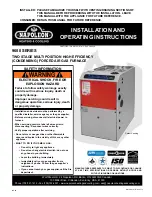
SERVICING
55
stat, and wiring.
If you have 24 volts coming off the transformer but re-
ceive approximately 13 volts on the terminal board be-
tween (C) and (R), check for blown fuse.
3. Check for 120 volts to the induced draft blower by mea-
suring voltage between Pin 1 (on the 2-pin connector)
and Line (Neutral) on the control board. No voltage, re-
place ignition control.
4. If voltage is present in Steps 1 through 3 and the in-
duced draft blower is operating, check for 120 volts to
the ignitor during the preheat cycle. Measure voltage
between Pin 2 (on the 2-pin connector) and Line (Neu-
tral) on the control board. No voltage, check pressure
switch.
5. After the ignitor warm-up time, begin checking for 24
volts to the gas valve. Voltage will be present for seven
seconds only if proof of flame has been established.
S-314 CHECKING FLAME SENSOR
A flame sensing device is used in conjunction with the igni-
tion control module to prove combustion. If proof of flame is
not present the control will de-energize the gas valve and
"retry" for ignition or lockout.
WARNING
HIGH
VOLTAGE
D
ISCONNECT
ALL
POWER BEFORE SERVICING OR
INSTALLING THIS UNIT.
M
ULTIPLE POWER SOURCES MAY
BE PRESENT.
F
AILURE TO DO SO MAY CAUSE PROPERTY
DAMAGE, PERSONAL INJURY OR DEATH.
1. Connect a micro-amp meter in series with this wire and
the sensor terminal.
2. Be sure the positive side of the meter is to the sensor
(depending on the model) and the negative side of the
meter is to sensor terminal.
L
INE VOLTAGE NOW PRESENT
WARNING
3. Place the unit into a heating cycle.
4. As soon as flame is established a micro-amp reading
should be evident once proof of flame (micro-amp read-
ing) is established, the hot surface ignitor will be de-
energized.
5. The Integrated Ignition controls will have 1 to 4 micro-
amps. If the micro-amp reading is less than the mini-
mum specified, check for high resistance wiring con-
nections, sensor to burner gap, dirty flame sensor, or
poor grounding.
6. If absolutely no reading, check for continuity on all com-
ponents and if good - replace ignition control module.
NOTE:
Contaminated fuel or combustion air can create a
nearly invisible coating on the flame sensor. This coating
works as an insulator causing a loss in the flame sense
signal. If this situation occurs the flame sensor must be
cleaned with steel wool.





































